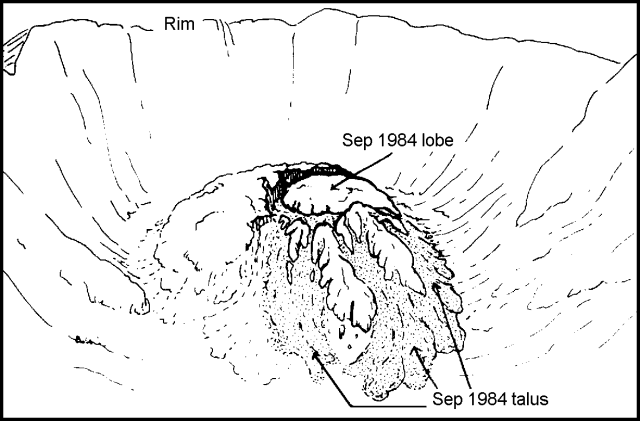Report on St. Helens (United States) — October 1984
Scientific Event Alert Network Bulletin, vol. 9, no. 10 (October 1984)
Managing Editor: Lindsay McClelland.
St. Helens (United States) Deformation, seismicity, and gas emission low
Please cite this report as:
Global Volcanism Program, 1984. Report on St. Helens (United States) (McClelland, L., ed.). Scientific Event Alert Network Bulletin, 9:10. Smithsonian Institution. https://doi.org/10.5479/si.GVP.SEAN198410-321050
St. Helens
United States
46.2°N, 122.18°W; summit elev. 2549 m
All times are local (unless otherwise noted)
Since the extrusion of a new lobe onto the composite lava dome in early September (figure 27 and SEAN 09:08 and 09:09), seismicity, deformation, and SO2 emission have returned to near background levels. Poor weather has limited observation of the crater, slow settling of the lava dome has continued, and rates of displacement averaged 4-5 mm/day in October. No large landslides were evident from field work or seismic records. Little vapor emission from the dome has been visible, but seismic instruments recorded signals apparently caused by very small steam and ash events, with as many as twenty on a single day (27 October) [but see SEAN 09:11]. Field observations on 1 November found no new tephra in fresh snow layers in the crater. Rates of SO2 emission averaged 75 ± 25 t/d in October. Very few earthquakes were recorded in October.
 |
Figure 27. Sketch of Mt. St. Helens, by Bobbie Myers, looking S, showing the dome after extrusion of the new lobe in early September 1984. |
Geological Summary. Prior to 1980, Mount St. Helens was a conical volcano sometimes known as the Fujisan of America. During the 1980 eruption the upper 400 m of the summit was removed by slope failure, leaving a 2 x 3.5 km breached crater now partially filled by a lava dome. There have been nine major eruptive periods beginning about 40-50,000 years ago, and it has been the most active volcano in the Cascade Range during the Holocene. Prior to 2,200 years ago, tephra, lava domes, and pyroclastic flows were erupted, forming the older edifice, but few lava flows extended beyond the base of the volcano. The modern edifice consists of basaltic as well as andesitic and dacitic products from summit and flank vents. Eruptions in the 19th century originated from the Goat Rocks area on the N flank, and were witnessed by early settlers.
Information Contacts: D. Swanson, C. Mullins, B. Myers, USGS CVO, Vancouver, WA; C. Jonientz-Trisler, University of Washington.

